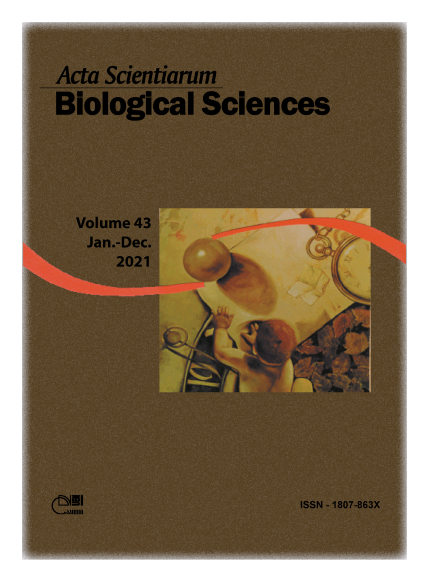Volatile chemical composition of Piper sancti-felicis Trel essential oil and its biocidal action against Tribolium castaneum (Herbst)
Resumo
This research assessed the fumigant activity of the essential oil from Piper sancti-felicis Trel and five of its components on the Tribolium castaneum (Herbst) biological model. Hydrodistillation was used for extraction of the essential oil, with separation and identification of the compounds through gas chromatography coupled to mass spectrometry (GC-MS). The fumigant was evaluated through gas dispersion on the T. castaneum. The majority compounds found in the EO were b-nerolidol (15.4%), 3-carene (14.9%), p-cymene (9.1%), spathulenol (8.2%), a-cubebene (6.2%) and calamenene (5.2%). Piper sancti-felicis displayed fumigant activity with a LC50 = 108.5 μg L-1 air, and other individual monoterpenes tested such as α-terpinolene (LC50 = 110.1 μg L-1 air), p-cymene (LC50 = 120.3 μg L-1 air), 3-carene (LC50 = 130.6 μg L-1 air), (R) -limonene (CL50 = 189.6 μg L-1 air), and a-pinene (LC50 = 213.1 μg L-1 air), were significantly less toxic than methyl pyrimiphos used as a positive control, CL50 = 87.4 μg L-1 air. The essential oil of P. sancti-felicis can be considered as a natural source of biocides.
Downloads
DECLARAÇÃO DE ORIGINALIDADE E DIREITOS AUTORAIS
Declaro que o presente artigo é original, não tendo sido submetido à publicação em qualquer outro periódico nacional ou internacional, quer seja em parte ou em sua totalidade.
Os direitos autorais pertencem exclusivamente aos autores. Os direitos de licenciamento utilizados pelo periódico é a licença Creative Commons Attribution 4.0 (CC BY 4.0): são permitidos o compartilhamento (cópia e distribuição do material em qualqer meio ou formato) e adaptação (remix, transformação e criação de material a partir do conteúdo assim licenciado para quaisquer fins, inclusive comerciais.
Recomenda-se a leitura desse link para maiores informações sobre o tema: fornecimento de créditos e referências de forma correta, entre outros detalhes cruciais para uso adequado do material licenciado.












1.png)




3.png)













